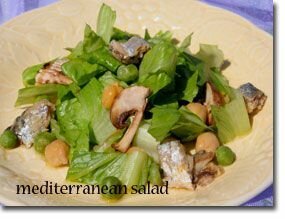Mediterranean Salad
Prep and Cook Time: 15 minutes; chilling time: 15 minutes
Ingredients:
- 2 cups chopped fresh tomato (cut out excess flesh if pulpy)
- 2 cups peeled chopped cucumber, seeds removed (cut lengthwise and scoop out seeds)
- ½ cup finely minced onion
- 2 clove finely minced garlic
- 1 can garbanzo beans, drained and rinsed
- 3 TBS fresh lemon juice
- 2 TBS chopped fresh mint
- 2 TBS extra virgin olive oil
- salt & cracked black pepper to taste
- 1 head romaine lettuce, use tender whole leaves for bed
Directions:
- Mix all ingredients together and chill. This is best if it chills for at least 15 minutes. Serve on bed of lettuce.
Healthy Food Tip
Should your foods be colorful?
In the world of processed food, you cannot judge the quality of a food by the way it looks. Artificial colors, mechanical processing techniques, and genetic engineering can create foods that look fantastic but have very little nutritional value. Don't judge your processed foods-or even in many cases, non-organic unprocessed foods-by their color; for example, it's sometimes the two parts per million of citrus red dye number 2 that gives the peel of conventionally grown oranges their rich color. (This artificial dye cannot be legally used on organic oranges.)
When eating the World's Healthiest Foods that have been organically grown, the situation is exactly the opposite. The more colorful your meal, the greater likelihood you will receive a rich diversity of nutrients. The World's Healthiest Foods are NATURALLY colorful. They are rich in phytonutrients that provide them with a rainbow of colors. The numerous phytonutrients in colorful fruits and vegetables have a variety of actions: they act as powerful antioxidants, have anti-inflammatory effects, help the way neurons communicate in the brain, and help reduce the effects of aging.
These phytonutrients give carrots and winter squash their rich orange-red color, make beets a brilliant red, and provide green leafy vegetables such as kale with their deep green hue. In fact, if you eat leafy greens like kale or mustard greens or chard, it's interesting to think about what happens to leaves in the fall to get a deeper appreciation for all of the phytonutrients included in these foods. During the fall, leaves change in color from green to yellow or orange or red; these colors are actually in the leaves year-round, but just get overshadowed by the green. Therefore, when you eat a green leafy vegetable, you're actually eating a variety of colors-and the phytonutrients that are reflected in those hues! Enjoy the World's Healthiest Foods for their colors and you will be also be enjoying them for their unique nutritional richness.
www.keralites.net         |
__._,_.___
KERALITES - A moderated eGroup exclusively for Keralites...
To subscribe send a mail to Keralites-subscribe@yahoogroups.com.
Send your posts to Keralites@yahoogroups.com.
Send your suggestions to Keralites-owner@yahoogroups.com.
To unsubscribe send a mail to Keralites-unsubscribe@yahoogroups.com.
Homepage: www.keralites.net
To subscribe send a mail to Keralites-subscribe@yahoogroups.com.
Send your posts to Keralites@yahoogroups.com.
Send your suggestions to Keralites-owner@yahoogroups.com.
To unsubscribe send a mail to Keralites-unsubscribe@yahoogroups.com.
Homepage: www.keralites.net
MARKETPLACE
.
__,_._,___

No comments:
Post a Comment